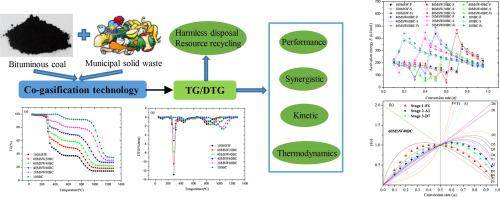Waste Management ( IF 7.1 ) Pub Date : 2020-11-09 , DOI: 10.1016/j.wasman.2020.10.028 Guangchao Ding , Boshu He , Huifeng Yao , Yucheng Kuang , Jingge Song , Liangbin Su

|
Co-gasification of municipal solid waste (MSW) with bituminous coal (BC) is an attractive alternative to realize the harmless disposal and energy harvesting of MSW. In this work, co-gasification characteristics and synergistic interaction of MSW and BC with CO2 atmosphere are studied by thermogravimetric method, including analyses of thermodynamics, kinetic parameters and reaction mechanism function. Results indicate that MSW gasification process can be divided into four main stages, and that of BC has only three main stages. Gasification temperature of coal char is much higher than that of MSW char, and addition of MSW can significantly improve the gasification reactivity of BC. Besides, a significant synergistic effect is observed for all the blends in char gasification stage. Based on three kinetic methods of Flynn-Wall-Ozawa (Xie et al., 2018), Starink (Zhang et al., 2019a) and Friedman, the minimum average activation energy Ea (184.13 kJ/mol) is obtained when the blend ratio of BC is 40% which might be an optimal option for co-gasification of the blends. The average values of the enthalpy, the Gibbs function and the entropy changes for sample 60MSW40BC are 176.82 kJ/mol, 257.89 kJ/mol and −89.16 J/mol·K, respectively. According to the Malek method, F6, A1 and D7 models are probably more suitable to describe three main stages of sample 60MSW40BC CO2 co-gasification.
中文翻译:

城市固体废物和烟煤与CO 2共气化的协同效应,动力学和热力学参数分析
城市固体废物(MSW)与烟煤(BC)的共气化是实现MSW的无害处理和能量收集的有吸引力的替代方法。在这项工作中,MSW和BC与CO 2的共气化特性和协同相互作用通过热重法研究了大气,包括热力学,动力学参数和反应机理功能的分析。结果表明,城市生活垃圾的气化过程可分为四个主要阶段,而卑诗省只有三个主要阶段。煤焦的气化温度远高于垃圾煤的气化温度,而垃圾的加入可以显着提高BC的气化反应性。此外,在焦炭气化阶段,对于所有共混物都观察到显着的协同作用。基于Flynn-Wall-Ozawa(Xie等人,2018),Starink(Zhang等人,2019a)和Friedman的三种动力学方法,最小平均活化能E a当BC的混合比为40%时,可获得(184.13 kJ / mol),这可能是共气共混物的最佳选择。60MSW40BC样品的焓,吉布斯函数和熵变的平均值分别为176.82 kJ / mol,257.89 kJ / mol和-89.16 J / mol·K。根据Malek方法,F6,A1和D7模型可能更适合描述样品60MSW40BC CO 2共气化的三个主要阶段。











































 京公网安备 11010802027423号
京公网安备 11010802027423号